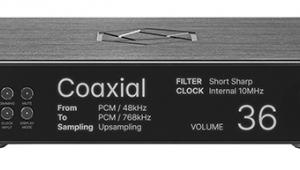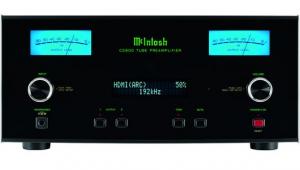Ear 192 Dacute (£4003/£4440)

Valve DACs are intrinsically anachronistic - Tim de Paravicini's new EAR-Yoshino DACute takes the retro attitude a stage further by sounding deliberately analogue
Hard to believe, I know, but the EAR-Yoshino 192 DACute Digital Audio Interface is the company’s first stand-alone D/A converter. The company has also produced CD players but, as main man Tim de Paravicini tells me, his previous experiences with digital mainly involved ‘bits of work for studios.’ But it was this studio connection that led Tim to develop the 192 DACute.
Given how word on the street pointed to the DACute as sounding ‘close to vinyl’ – this was said by more than one visitor to the EAR-Yoshino room at the Munich High-End Show – I simply had to ask Tim just how he ‘voiced’ the DACute. ‘The most succinct way I can put it is this: because of my experience in mastering discs, those are the qualities of comfort that I was looking for from a digital source – without cheating.’ He doesn’t come right out and say he was trying to emulate the easy silkiness of LPs, but it may seem that way.
PLAIN AND PROFESSIONAL
Because it is so ‘no nonsense’ and unadorned (the black finish costs less than chrome), you can actually imagine this unit finding a home in a professional milieu. The front panel contains a power on/off rocker far left and a rotary volume control on the right. Four illuminated buttons in a vertical row to the right of the on/off switch select CD, S/PDIF, Toslink or USB. To their right are the eight important indicators telling you when the signal has locked, if it’s 24-bit, and if it’s sampled at 44.1, 48, 88.2, 96, 176.4 or 192kHz. That pretty much covers every essential rate at present, so digiphiles can have a field-day.
Inside the 192 DACute is a Crystal S/PDIF receiver, covering legacy transports, while it’s able to accept up to 24/192 material from USB, coaxial S/PDIF and Toslink inputs. Tim designed the analogue fi lters, while the audio signal exits via a line output stage containing a pair of transformercoupled ECC88 valves. The output section is said to be modelled on EAR’s studio equipment, and a look around the back reveals – in addition to the aforementioned necessary inputs – a pair of RCA-phono sockets for unbalanced line out and a pair of XLRs for true balanced operation as preferred in studios. I used the latter throughout my listening sessions, fed into the Audio Research Ref 5 preamp.
I mentioned a volume control: the 192 DACute’s maximum output is 5V, so it can drive pretty much any power amplifi er directly. As EAR-Yoshino provides this with a neat, hand-held remote for volume and source selection, shaped not unlike that for the B&W Zeppelin, you can use the 192 DACute as a preamp, which certainly enhances its value-for-money.
Despite it seeming almost minimalist, I still had to indulge in all manner of wireswapping, feeding this unit at various times from the digital outputs of the Marantz CD12, the Tevion Blu-ray player, an elderly Denon DVD2900 and the brand-new Cambridge Azur 751BD universal players for DVD-As, a couple of PCs and – in the hope that I could get the USB to work with Linux – my wee Asus EEEPC. Which it could not fi nd. Tim says that EAR-Yoshino will be updating the drivers continually, and I’m fairly confi dent that anyone eager to hear their 192kHz downloads can fi nd a workable solution.
YES, IT’S MORE ANALOGUE
Although I sampled every oddball recording I could fi nd, from the Beatles’ 24-bit remastered collection to a selection of tracks uploaded to my PC using assorted codecs to high-res downloads transferred to DVDs, I spent most of my time assessing the EAR-Yoshino with the most consistent of digital sources: CDs. With a choice of transports, I was able to use 75ohm coaxial S/PDIF and Toslink, inadvertently enjoying a shoot-out amongst the transport sections. Yes, the Marantz CD12 still ‘rules’ for me, but I was staggered at how good the Denon DVD-2900 sounds, so that’s a second-hand bargain if you can fi nd one, while the new Cambridge is, well, a perpetual delight [see HFN Aug ’11].For the rest of the system, I used Quad II-eighty monoblocks, Wilson Sophia 3 loudspeakers and YTER and Atlas cables, as well as the latest interconnect from Lieder. The 192 DACute slipped right in, making itself at home after a brief warmup of only 15 minutes. There are no set-up tips I can offer other than keeping its rear vents unobstructed, while tweak-geeks will enjoy playing with VPI bricks and such-like, positioned directly over the power supply. It’s not that the EAR-Yoshino needs such aftermarket meddling: it’s just that this unit seems to be tuned to a critical degree, like the setting-up of a racing car. You hear each change, but only you can decide if it’s an enhancement. My remarks refer to the DAC in its virgin state, resting on a GM Accessori table.
There’s no period of unfamiliarity with this component. You hear immediately that the whispers are all true: it really does sound somehow more ‘analogue’, by whatever means Tim has managed this. It’s not merely a matter of valves in the path, because DACswith- tubes have been around for over 25 years. And though, back in the early days of the CAL Tempest II, we savoured the added warmth when applied to the then new and curiously artificial sound of CDs, we knew we were hearing the tubes and not the music itself. Something about Tim’s remark that he wanted to achieve this ‘without cheating’ rings true. It’s not a case of fattening up the sound for the sheer hell of it. But that effect was a constituent part of the experience. When playing Keb’ Mo’s version of ‘For What It’s Worth’, which I cherish for its rhythm section, I was faced with a new sensation from the Wilson Sophia 3s.In normal practice, the Wilsons deliver the most precise, extended, uncoloured and detailed bass any music lover could want from such a compact system. Even the redoubtable Hughie Day at the Emporium – a vintage hi-fi maven not known for his love of this speaker – sat in my listening room agog at the lower registers. The EAR-Yoshino, in direct contrast to the company’s classic amplifiers, treated the Wilson’s bottom octaves as if they were goosedown pillows being plumped up by a maid.
A TOUCH OF SOUL
Is this right or wrong? I neither know nor care, for I am certain that the drier performance is the more accurate. But accuracy be damned: the addition of a bit of heart, a touch of soul, was neither intrusive nor disconcerting. Simply put, it made the CDs sound more like the vinyl. Less aggressive, less edgy – but there must surely be a line not to cross?
Dolly Parton’s sassy, brassy ‘Put A Little Love In Your Heart’ can make even porcelain fillings hurt. I don’t know why, but post-1970s Country & Western recording engineers seem to have forgotten all that Owen Bradley and Chet Atkins knew. Via the EAR-Yoshino, Dolly sounded like her session took place in the same era as early Wanda Jackson or Patsy Cline. The greatest transformations take place at the frequency extremes, the midband retaining its original purity, while there is never any sense of apparent loss – neither in the details nor the sense of air. It’s a big, majestic recording, filling the room just as comprehensively through the EAR-Yoshino as it does through other DACs – Marantz DA12, a couple of Musical Fidelity models, an HRT or two. But among them, the closest in resemblance to the ‘192 DACute Effect’ was the Musical Fidelity KW25 DAC’s valve output option.
This is telling you little, I fear. It’s as if I’m prescribing the old Musical Fidelity X10-D buffer, which was a wonderful way of ameliorating the sins of coarse budget kit. No, this is a far more sophisticated makeover, like the rare cases when Botox works, instead of turning the patient into a piscean grotesque. It’s tricky to defi ne, because it suggests alterations while little, if nothing, has changed.
Take the newly-released Rockpile album, Live At Montreux 1980. It’s not a disc you’d buy for its sonic merits. You buy it because Rockpile were one of the greatest bands of the past 40 years. If you can tear your ears away from irresistible renditions of ‘Queen Of Hearts’, ‘So It Goes’, ‘Girls’ Talk’, ‘I Hear You Knocking’ and a dozen other gems, if you can listen beyond Dave Edmunds’ and Billy Bremner’s chunky guitars, Nick Lowe’s flowing, rhythmic electric bass or Terry Williams’ staccato drumming, you’ll hear the crowd, you’ll sense the recording venue.
Through normal decoders, one is aware of the scale, the dimensions and – if your speakers image well – the ambience. These are part and parcel of any high-end system. It’s only by moving on to the 192 DACute that you detect something else, a more realistic presentation of the hall and its topology. You feel as if you can walk into the venue, only you’d confront solid images rather than 2D cutouts on different planes. Combine this more natural, ‘breathing’ atmosphere with richer, more fluid bass, and extended, fast but non-aggressive treble transients, and you’re faced with something as euphonic as a 1968 Radford valve amplifier, but with the precision of a circa-2011, cutting-edge solidstate behemoth. Yes, we’ve heard such deft juggling in the past, most notably from valve/transistor hybrids, but this has to be one of the most successful implementations I’ve heard so far in a DAC.
MUCH NEEDED MUSICALITY
Perhaps we should not be surprised, because EAR-Yoshino has, of late, been increasingly more commercially savvy, selling user-friendly, attractive gear that’s unabashedly high-end, but without the tears. This philosophy has been applied to one of the few equipment classifi cations that nobody ever expected to be ‘relevant’ again. After years of hoo-hah about the importance of standalone DACs and separate transports, they seemed to disappear, only to be revived as the market became inundated with new digital sources.
From iPod to iPad to streaming to downloads, separate DACs with a plethora of inputs and all-embracing decoding capabilities make more sense than they ever did when all we had were CDs. EAR-Yoshino, with this piece of equipment, has injected a much-needed dose of musicality into what otherwise could be unbearably sterile.
Using recordings dripping with emotion – the latest from Lori Lieberman and Eleanor McEvoy – every vocal nuance reaches the listener, increasing the intimacy that transforms them from mere singersongwriters into welcomed therapy. It’s true, of course, that these two know how to make recordings so ‘real’ that they have an inherent sonic advantage over major-label crud. What the 192 DACute does is ensure delivery. You can almost reach out and touch them (if that doesn’t sound a bit too creepy).
On a rare, country-flavoured set from Michael Brown, late of the Left Banke, his interpretation of the old Johnny Cash chestnut, ‘Get Rhythm’ was assembled from acoustic and electric guitars, slapping percussion, sweet harmonies. It’s a superclean recording that a cod-valve sound could muddy. This DAC turns up the heat, but never lets it boil over. It is, undeniably, the DAC for people who wish digital never happened.
VERDICT
This DAC breaks so many rules that you have to approach it in a Kierkegaardian manner: if you love vinyl and tapes, you’ll need no convincing. I’m not technosavvy enough to know if the DACute is particularly noteworthy in purely digital terms, but I’ll tell you this: it narrows the gap between LP and CD better than any DAC I can recall. All Tim left out is an effects button to add surface noise.
Originally published in the November 2011 issue



















































